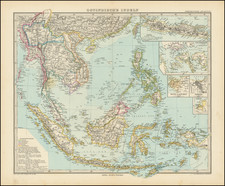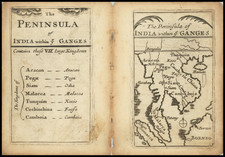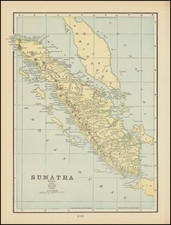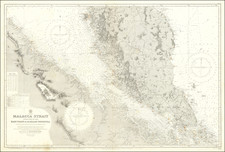The First Appearance in Print of the Raffles Plan - the First Published Plan of Singapore.
Two cornerstone engraved maps of Singapore on one sheet, issued by Henry Colburn in London in 1828.
The top map, Plan of the British Settlement of Singapore. by Capt. Franklin & Lieut. Jackson, is a fine early mapping of what is now the nation of Singapore. However, it is the plan below, Plan of the Town of Singapore. by Lieut. Jackson, that is of greatest importance.
This map was commissioned by Stamford Raffles upon his return to Singapore 1822, three years after he had founded the British colony in 1819. When he returned to Singapore, Raffles found that the city had grown rapidly in his absence without a formal plan to control and direct its expansion. Raffles ordered the newly-arrived Lieutenant Philip Jackson to map the colony so that a formal urban plan could be drawn up.
Raffles's plan for Singapore Town called for numerous new policies, perhaps most notably, the formal racial segregation of the city. The largest section of Singapore Town was indicated for the Chinese, whom Raffles estimated would constitute the largest part of the local population. Europeans were to live in the area around Rocher Square, with the Bugis camping farther to the north. These areas are indicated on the present map.
The map appears in John Crawfurd's 1828 Journal of an Embassy from the Governor-General of India to the courts of Siam and Cochin-China... The separate map rarely appears on the market.
J. & C. Walker was the imprint used by the Walker family of engravers and printers. They produced numerous high-quality geographical maps and nautical charts for a variety of institutions in the nineteenth century. John Walker (1787-1873) held the position of Hydrographer to the East India Company, a position also held by his father and namesake. John worked in partnership with his brothers, Charles and Alexander. The brothers published over 200 maps for the Society for the Diffusion of Useful Knowledge. They produced maps for James Horsburgh and the Admiralty, as well as the influential Indian Atlas.

![(First Printed Plan of Singapore) Plan of the British Settlement of Singapore. by Capt. Franklin & Lieut. Jackson [on sheet with:] Plan of the Town of Singapore by Lieut. Jackson By J & C Walker / Henry Colburn](https://storage.googleapis.com/raremaps/img/small/102820.jpg)












